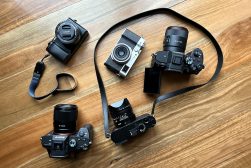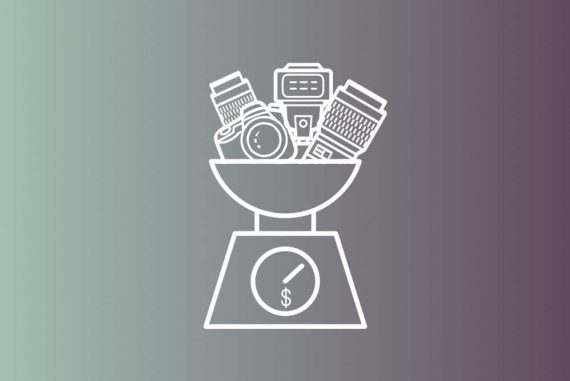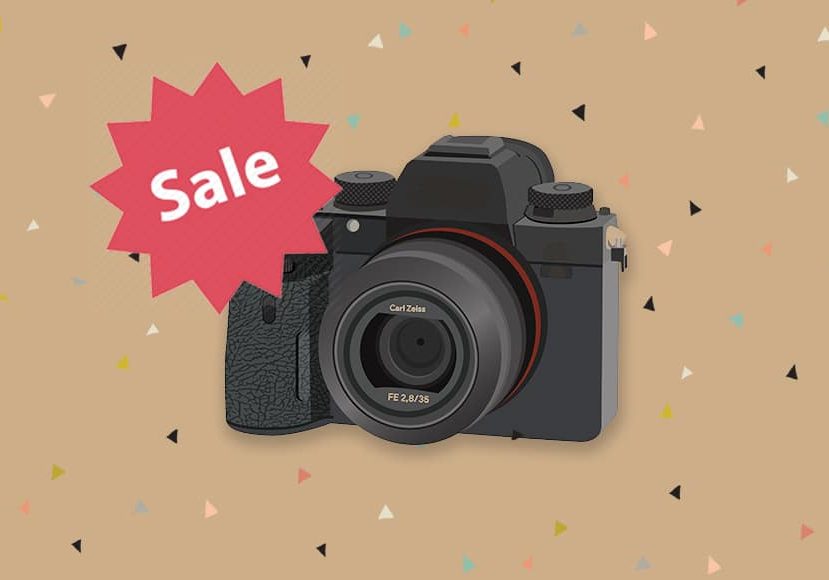
Best Budget Camera for Inexpensive Photography in 2024
Don't miss this revealing guide to the best budget cameras of the year, including mirrorless, DSLRs, point and shoots, drones and phones.
Camera Gear Guides | Camera Guides | By Don Machuca and Mark Condon
This guide to the best budget camera for photography will help you save money and take better photos!
It’s never been a better time to get into photography. There are more cheap cameras with great image quality than ever before.
However, you need to know what to look for! Image quality on many budget cameras is actually worse than a modern phone camera, so stick to our recommendations below.
In this guide, you’ll discover the best cheap camera for photography beginners, for travelling, for YouTube and even for video.
We also include the best budget camera phones since sometimes, you don’t even need a digital camera to get a great pic.
And if your budget can’t stretch to the products below, you can always buy a used camera from here.
What is the Best Budget Camera in 2024?
| Image | Product | Features | |
|---|---|---|---|
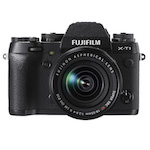 | Fujifilm X-T1BEST OPTION FOR BEGINNERS |
| Check Amazon Price → |
 | Sony Alpha a6000AMAZING VALUE FOR MONEY |
| Check Amazon Price → |
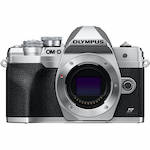 | Olympus OM-D E-M10 Mark IVGREAT FOR CHEAP LENSES |
| Check AMAZON Price → Check B&H Price → |
 | Canon EOS M50/Mark IIBEST BUDGET PHOTOGRAPHY /VIDEOGRAPHY |
| Check AMAZON Price → Check B&H Price → |
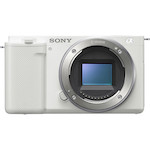 | Sony ZV-E10ALSO GREAT FOR VIDEO |
| Check AMAZON Price → Check B&H Price → |
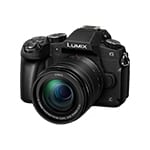 | Panasonic Lumix G85GREAT FOR YOUTUBE VLOGGING |
| Check AMAZON Price → Check B&H Price → |
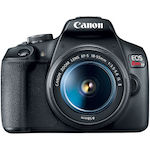 | Canon EOS Rebel T7BEST BUDGET DSLR |
| Check AMAZON Price → Check B&H Price → |
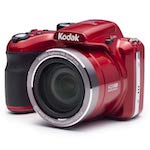 | Kodak PixPro AZ421BEST FOR TRAVELLING |
| Check Amazon Price → |
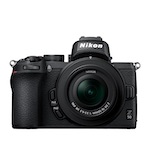 | Nikon Z 50BEST BUDGET STRETCH |
| Check AMAZON Price → Check B&H Price → |
| Google PixelBEST BUDGET (ANDROID) |
| Check AMAZON Price → Check B&H Price → | |
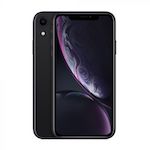 | iPhone XRBEST BUDGET (IOS) |
| Check Amazon Price → |
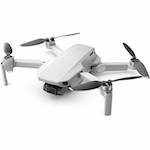 | DJI Mavic MiniBEST CHEAP DRONE |
| Check Amazon Price → |
Fujifilm X-T1 | Best Cheap Camera for Photography Beginners

- Excellent build quality
- Weather-sealed and freezeproof
- Excellent image quality
- Gorgeous retro looks
- Great manual controls (dial placement)
- Fun in-camera film simulations
- Good dynamic range in RAW files
- Fast playback speed
- Fast burst mode and great buffer
- Fiddly 4 way controller buttons
- Viewfinder lag during burst mode
- Confusing menus
Specs: 16.3MP APS-C X-Trans CMOS II Sensor | EXR Processor II | 0.5″ 2,360k-Dot 0.77x OLED Viewfinder | 3.0″ 1,040k-Dot Tilting LCD Monitor | Full HD 1080p Video Recording at 60 fps | Built-In Wi-Fi Connectivity | Continuous Shooting up to 8 fps | Intelligent Hybrid AF System | Film Simulation Mode and Classic Chrome | Weather-Resistant Body Construction.
This is one of the best affordable digital cameras for beginner photographers.
If you can find the Fujifilm X-T1 still in stock, snap it up while you still can. Released back in January 2014, this is the camera that revolutionised photography by making the APS-C sensor sexy again!
With a drop-dead gorgeous retro film camera-inspired body design (available in all black or black/silver), the Fujifilm X-T1 is a real head-turner. Fortunately, it’s as good inside as it is out, with amazing image quality, whether you’re shooting with the film-look presets in JPEG or in RAW.
(My preference with Fujifilm cameras is only to shoot JPEG, since they look so damn good straight out of camera – you don’t need to waste any time in front of the computer editing!)
However, if you do choose to shoot RAW (or RAW + JPEG, so you have both options), the RAW files have plenty of dynamic range so you can squeeze every last highlight and shadow detail out of your images.
Burst mode on the Fujfilm X-T1 is impressive at 8fps and the buffer is large enough for you to keep your button pressed down on the shutter button and not have the camera freeze up. Playback speed is also blazing fast, meaning you can review your shots quickly and easily.
The WiFi transfer mode is a handy feature that lets you send your images to a smartphone or tablet to share on social media, and everything works smoothly with the Fujifilm app.
The Fujifilm X-T1 offers well-placed manual control dials and knobs in a compact, lightweight body that feels as good as it looks.
Since it’s an older camera with multiple successors, this may not be the cheapest camera but you can still find it for an absolute bargain – it’s our choice of the best cheap camera for beginners, but more advanced photographers will love it too.
(I know plenty of professional wedding photographers who built their businesses off the back of the X-T1!)
One more huge benefit of buying this mirrorless camera is that it gives you access to the world of incredible Fujifilm X-series lenses with so many options at competitive prices.
It’s the best inexpensive digital camera – the only challenge is finding it in stock!
Sony Alpha a6000 | Amazing Value for Money
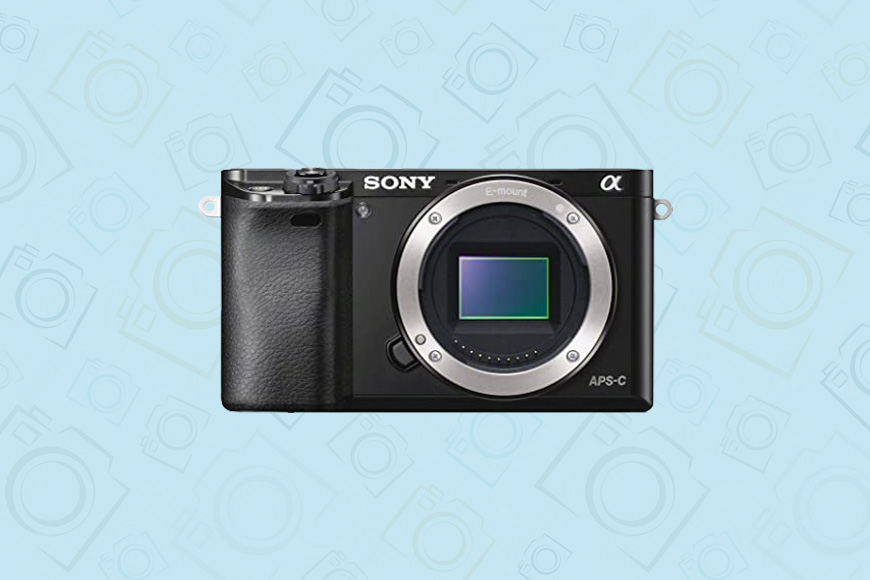
- Lightning fast autofocus
- Impressive 11fpx burst speed
- Compact and lightweight
- Tilting LCD screen for hip-level shooting
- Great image and video quality
- Slow to start up
- Lower resolution screen
- No mic input
Specs: 24.3MP APS-C Exmor APS HD CMOS Sensor | BIONZ X Image Processor | Tru-Finder 0.39″ 1,440k-Dot OLED EVF | 3.0″ 921k-Dot Xtra Fine Tilting LCD | Full HD 1080p XAVC S Video at 24/60 fps | Built-In Wi-Fi Connectivity with NFC | Fast Hybrid AF & 179 Phase-Detect Points | Up to 11 fps Shooting and ISO 25600 | Multi-Interface Shoe and Built-In Flash | Sony 16-50mm f/3.5-5.6 OSS Zoom Lens Included.
Announced back in February 2014, the Sony a6000 is another absolute steal for the money, so long as you can find it in stock.
It makes it to our best budget cameras list as one of the cheapest mirrorless cameras you can buy and continues to be one of the best-selling cameras ever.
It packs a 24.3 megapixel APS-C CMOS sensor with full HD recording at 1080p, a tilting 3-inch LCD display, Wifi and even NFC connectivity.
The main drawcard of the Sony a6000 is speed – lightning fast autofocus coupled with 11fps burst shooting with tracking focus means that you can happily shoot any fast-moving sports event with this compact camera and not miss a shot.
JPEG and RAW image quality are both great, with excellent high ISO performance from an APS-C sensor camera.
Obviously, the low light capabilities won’t rival any full frame cameras, but it’s still more than enough for most photographers to get a sharp shot without flash after dark.
The Sony a6000 is small enough to slip in a jacket pocket, so long as you pair it with a kit lens or compact prime – there are tons of amazing Sony e-mount lenses on offer which pair beautifully with this camera.
24mp is a sweet spot in resolution – it’s big enough to allow some cropping or large prints but not too big to slow down your computer when it comes to editing the files.
Video quality is decent, and the WiFi/NFC is great for sharing your media across all your devices via the Sony Imaging app.
For around $500, it’s hard to get a mirrorless camera as good as the Sony a6000, even several years after its release.
You’ll find various other Sony a6xxx models at higher prices on sale, but the a6000 is one of the best cheap cameras you’ll ever come across. It really is amazing value for money.
Olympus OM-D E-M10 Mark IV | Best Economical Digital Camera for Cheap Lens Range
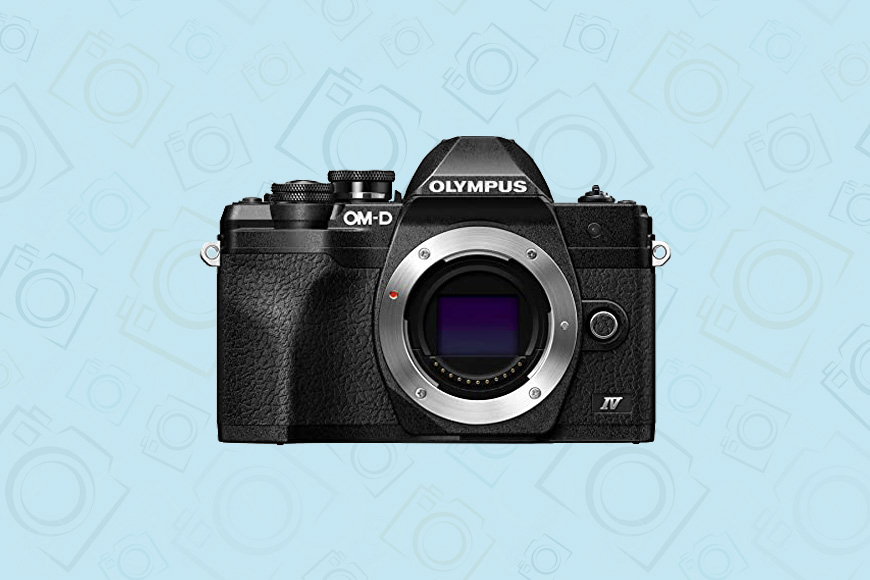
- Small and lightweight
- Excellent image quality
- Wifi and Bluetooth for convenient sharing
- Flip-down touchscreen display
- 5-axis in-body image stabilization
- Access to cheap micro 4/3 lenses
- Decent 4k video
- Slower autofocus than competitors
- Slower burst speed (4.5fps)
- Confusing menu
- No external microphone or headphone input
Specs: 20.3MP Four Thirds Live MOS Sensor | TruePic VIII Image Processor | UHD 4K30p Video Recording | 2.36m-Dot 0.67x OLED Electronic Viewfinder | 3.0″ 1.04m-Dot Vari-Angle Touchscreen | 5-Axis Sensor-Shift Image Stabilization | ISO 200-25600, Up to 15 fps Shooting | 121-Point Contrast-Detect AF System | Built-In Wi-Fi and Bluetooth | In-Body 2.36m-Dot 120 fps AF-C Tracking.
Despite being quite a mouthful of a camera name, the Olympus OM-D E-M10 Mark IV is a cute and compact, retro-inspired micro 4/3 sensor mirrorless camera with legions of fans.
Without getting too technical, the main thing you need to know about a micro 4/3 camera is that it’s smaller than APS-C sensor cameras, and so are its lenses.
This is obviously great for travel or as an everyday walkaround camera, but it also means that micro four thirds lenses are also cheaper than their counterparts.
At around $700, the Olympus OM-D E-M10 Mark IV may be slightly pricier than the other cheap cameras we recommend, but it makes up for this when paired with a micro 4/3 lens, which is usually much cheaper than a lens for an APS-C sensor camera.
Image and video quality out of the OM-D E-M10 Mark IV is great, but being a smaller sensor, it can struggle in low light at higher ISOs.
However, to combat this, the 5-axis in-body image stabilization lends a hand with up to 4.5 stops, meaning that you can shoot handheld in low light without a flash and still get sharp results at low-ish ISOs.
The flip-down touchscreen display is a nice touch that makes shooting at waist-level a cinch – being able to tap a subject to take a photos is a fun and easy process that makes people photography much easier and less obtrusive.
4.5fps burst shooting is on the slow side, but as long as you’re not shooting fast-paced sports, it should be more than enough for everyday photography.
I recommend getting this camera with the kit lens, then when you’re ready, invest in a fast prime or zoom lens to really make the camera sing.
While there may be cheaper cameras out there, the benefit of access to cheaper lenses is a big plus for anyone on a tight budget.
Canon EOS M50 Mark II | Best Budget Camera for Photography and Videography
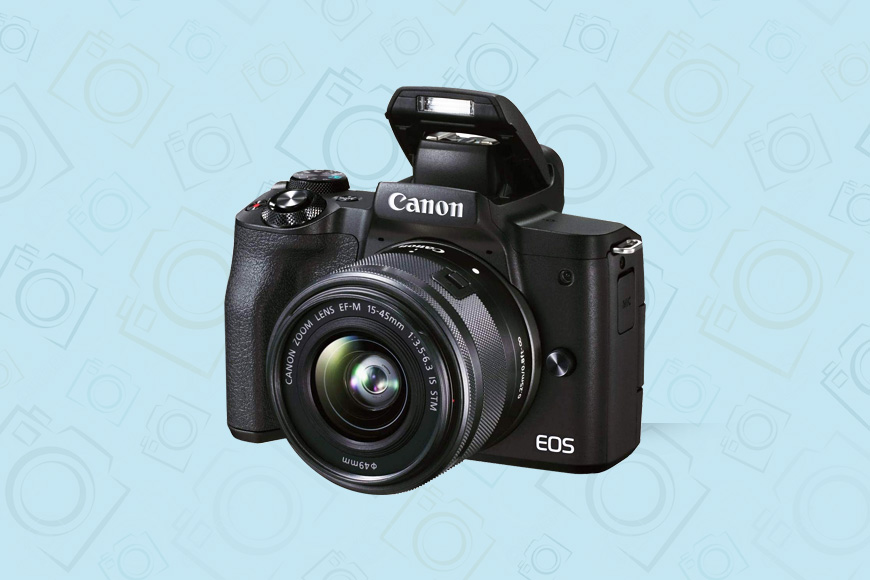
- Great eye-detect / face-tracking autofocus
- Great image and video quality
- Good ergonomics despite compactness
- Flip out touchscreen interface
- 10fps burst mode
- Supports external microphone
- Webcam mode can be useful
- Cropped 4k video
- Confusing menus
- Lack of customization
Specs: 24.1MP APS-C CMOS Sensor | DIGIC 8 Image Processor | UHD 4K and HD 720p120 Video Recording | Dual Pixel CMOS AF with Eye Detect AF | 2.36m-Dot OLED Electronic Viewfinder | 3.0″ 1.04m-Dot Vari-Angle Touchscreen | Wi-Fi and Bluetooth Connectivity | Automatic Image Transfer to Mobile Devices | EF-M 15-45mm f/3.5-6.3 IS STM Lens | 143 AF Points and Creative Assist Mode.
The Canon EOS M50 is a hugely popular series, and the Mark II is one of the best cheap cameras I’ve come across. This is certainly one of the best cheap digital cameras for beginners and advanced photographers alike.
Built like a mini DSLR, it’s compact and lightweight enough to carry around every day, while still offering all the main knobs and buttons most photographers need.
It’s one of the few cheap cameras that offer 4K video footage, although it is cropped at 24p, and the dual-pixel AF doesn’t function, so 1080p is a much better choice.
In 1080p, the EOS M50 Mark II uses Canon’s excellent dual-pixel autofocus which allows you track the eyes of your subject. In testing, the AF worked well in both normal and low light situations, making filming people a breeze.
One notable addition if you’re a fan of live streaming or video conferencing is this camera’s ability to be used as a webcam in conjunction with the EOS Webcam Utility Software. If you choose the right wide-angle lens, you can get much better quality than your existing webcam.
In terms of regular shooting, the 10fps burst mode is fast enough for any application and you’ll get about 25 JPGs or 15 RAWs before the buffer starts filling up.
The 24mp sensor delivers sharp, vibrant JPEGs, and the RAW capture is impressive as well. The EOX M50 Mark II is one of the few cheap cameras to offer a built-in flash which can come in handy when the light starts to drop.
Overall, it’s definitely an entry-level Canon camera that’s aimed at beginners, but if you want something that does well for both photography and video at a killer price point, this is the one to get.
Sony ZV-E10 | Lowest Price Digital Camera for Quality Vlog Content Creation
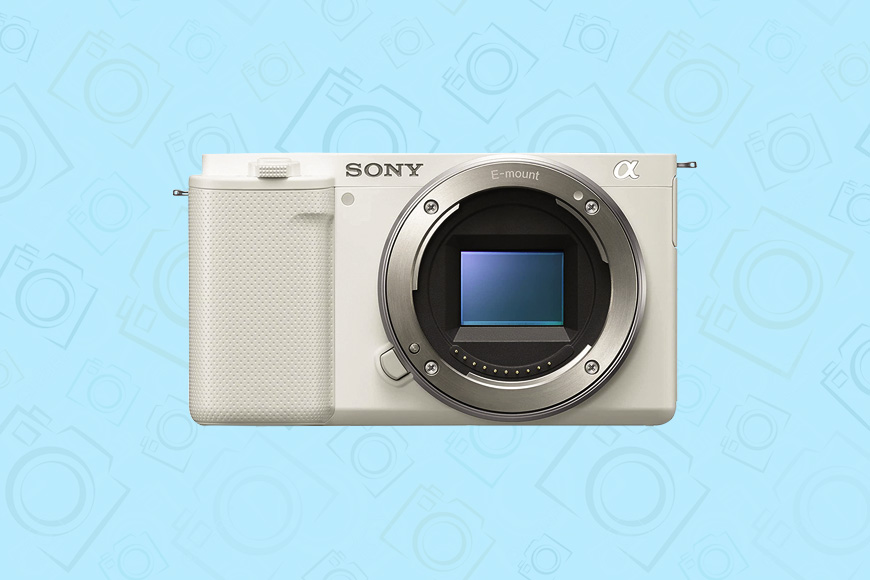
- Great face and eye autofocus
- Defocus button useful for creating bokeh
- Fully articulating LCD
- Clear recording indicator
- Clear in-camera microphone
- Poor battery life
- Crop in action mode
- Limited touchscreen functionality
Specs: 24.2MP APS-C Exmor CMOS Sensor | BIONZ X Image Processor | UHD 4K and Full HD Video Recording | 3.0″ Side Flip-Out Touchscreen LCD | Real-Time Eye AF and Face Priority AF | Directional 3-Capsule Microphone | Product Showcase Setting | Background Defocus Function | Skin Tone and Soft Skin Effect | Built-In Wi-Fi and Bluetooth Connectivity.
As one of the most popular cameras for vlogging of the year, it may be surprising that the Sony ZV-E10 falls into our best cheap cameras.
Created specifically for the needs of vloggers and YouTube content creators, the ZV-E10 has that all-important fully-articulating LCD screen that allows you to see your face when you’re filming.
In addition, there’s a handy thick red box which surrounds the frame to indicate when you’re actually recording – much easier to see than the usual tiny red dot that other cameras utilise as a recording indicator.
There’s no 4k video capture at 60p, but that’s to be expected from a camera at this price point. However, 4K at 24 and 30fps looks great, and that’s all most people will ever need. If you are just starting out, this makes it one of the best budget digital camera deals you could ever have.
By utilising a three-capsule microphone plus the included windscreen (‘dead cat’), sound quality is great and reduces the need to use any obtrusive external mic. It’s also super-portable too.
As for image quality, the ZV-E10 uses a 24MP CMOS sensor to take stills photos, meaning pictures look identical to the more expensive Sony a6100.
JPEGs look vibrant and punchy straight out of camera, and RAW capture is decent too, with lots of room to play with the files in post-production. Low light shooting is decent up to around ISO6400, which is normal for an APS-C camera.
Overall, the Sony ZV-E10 is a vlogging camera that’s also good for photos. If you’re tossing up between this and the aforementioned a6000, the ZV-E10 is the newer model and offers better video features, but it’s also more expensive.
Panasonic Lumix G85 | Great for Youtube Vlogging
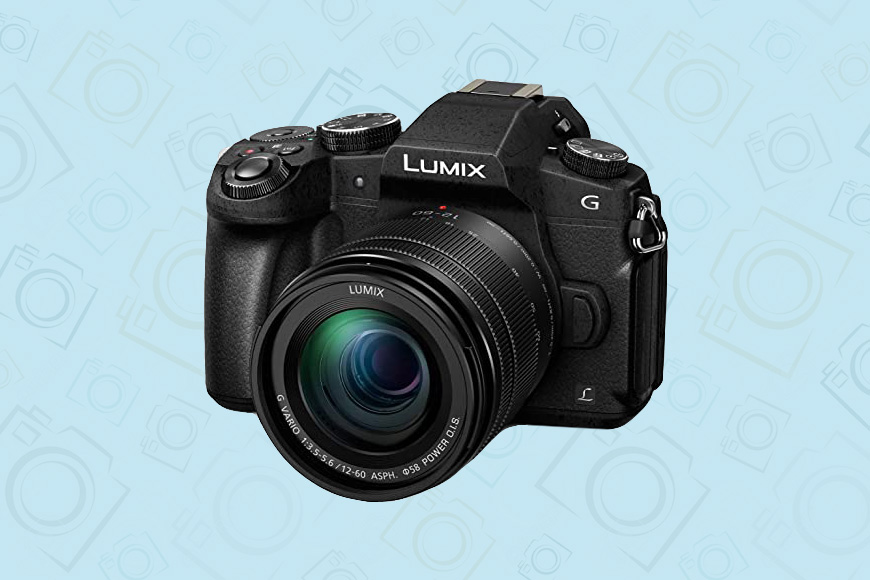
- Fast and accurate autofocus
- Excellent video quality
- Great image quality
- Robust, weather-sealed build
- Poor battery life
- No headphone jack
Specs: 16.0MP Live MOS Sensor | Venus Engine Image Processor | UHD 4K Video Recording at 30/24 fps | 2.36m-Dot Electronic Viewfinder | 3.0″ 1.04m-Dot Swivel LCD Touchscreen | 5-Axis Sensor Stabilization; Dual I.S. | ISO 25600 and 10 fps Shooting with AF-S | LUMIX DFD Focusing System | 4K Photo Modes and Post Focus | Weather-Sealed Magnesium Alloy Body.
While the Sony above is great for run-and-gun style vlogging, the Panasonic Lumix G85 is our best cheap camera for YouTube.
it offers 4K video up to 30p, mic input, Cinelike picture styles, focus peaking, exposure zebra lines, 100Mbps bit rate recording and various other videographer-centric features.
The G85 is styled like a mini DSLR, and shares the ergonomics and build quality of a much bigger, much more expensive camera too.
It’s fully weather-sealed and uses Panasonic’s excellent Dual I.S.2 image stabilization technology, which gives up to 5-stops of balance, allowing you to shoot handheld with far slower shutter speeds than you would otherwise.
There’s an interesting 4k Photo mode, which lets you record 8MP JPEG images at up to 30fps in a kind of super-burst mode. This leaves you with a ton of pictures to choose from, ensuring you get the shot you need when it matters.
Autofocus is accurate and lightning fast, especially since it’s a mirrorless camera that relies only on contrast-detect AF.
Continuous shooting in burst mode is an equally impressive 9.3fps, and the buffer never seems to fill up when shooting in JPEG. In RAW format, you can shoot up to 7fps for over 60 seconds before the buffer needs to clear.
The 3″ 1.04M dot fully articulating LCD screen looks fantastic and helps you get some creative angles while shooting or filming yourself.
All in all, even though we recommend the Lumix G85 for video shooters, it’s also a great addition for any sports or wildlife photographer needing great autofocus and fast shooting speeds.
The 16MP micro four-thirds sensor does a great job and opens the doors to a range of bargain-priced micro 4/3 lenses to attach to the G85.
Canon EOS Rebel T7 | Best Budget DSLR

- Excellent value for money
- Great image quality
- Good ergonomics for larger hands
- Pop up flash
- Limited burst mode speed
- Odd aspect ratio choice for LCD screen
Specs: 24.1MP APS-C CMOS Sensor | DIGIC 4+ Image Processor | 3.0″ 920k-Dot LCD Monitor | Full HD 1080/30p Video Recording | 9-Point AF with Center Cross-Type Point | ISO 100-6400, Up to 3 fps Shooting | Built-In Wi-Fi with NFC | Scene Intelligent Auto Mode | Creative Filters and Creative Auto Modes | EF-S 18-55mm f/3.5-5.6 IS II Lens Included.
So far, this list of the best cheap cameras has concentrated on mirrorless cameras, but here’s a great budget DSLR to throw into the mix.
Nikon also makes a few decent cheap DSLRs, but we’re recommending Canon for this article since the associated lenses are marginally cheaper.
The Canon EOS Rebel T7 was launched back in 2018, meaning you can get it with a kit lens for around $500. This makes it an absolute steal for anyone who wants to experiment with a DSLR.
With only 3fps in burst mode, the T7 is clearly outclassed by more modern cameras (or indeed, by most of the other cheap cameras in our guide), but what it lacks in speed, it makes up for in user-experience.
DSLRs feel outdated here in 2024 when compared to the best mirrorless cameras on offer, but some photographers still prefer them. There’s something about using an OVF as opposed to an EVF for more mindful photography.
The 9-point AF system is also distinctly lacking when compared to other cameras at this price point, but as long as you’re not trying to track fast moving subjects, you should be just fine.
Buying a cheap Canon DSLR like the T7 also means you gain access to some great value Canon EF lenses, like the ‘nifty-fifty’ 50mm f/1.8 – on this camera, it’s a fast, lightweight portrait lens, and one of the cheapest you’ll find.
The EOS Rebel T7 features a Digic-4 Plus image processor, which produces colourful and rich images with lots of detail. Image quality will vastly improve when you upgrade from the kit lens, too.
All in all, if you’re after a DSLR for around $500, this is the one to get.
Kodak PixPro AZ421 | Best for Travelling
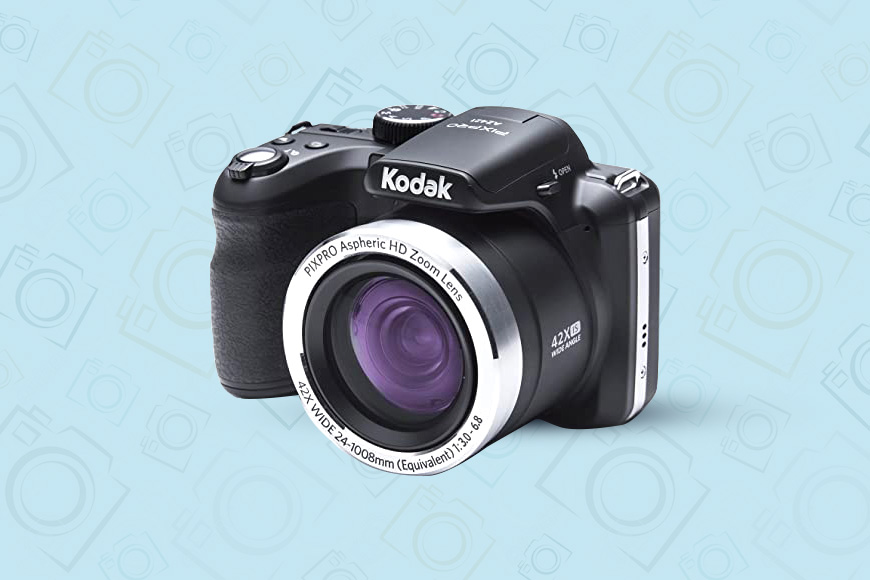
- 42x zoom offers incredible closeups
- Useful 24mm wide angle lens
- Comfortable ergonimics
- Great image quality
- In-body battery charging
- Simple menus
- Poor battery life
- 720p video
Specs: 16.15MP 1/2.3″ CCD Sensor | 4.3-180.6mm (35mm Equivalent: 24-1008mm) Lens | 42x Optical Zoom Lens, 4x Digital Zoom | 3.0″ 460k-Dot LCD Monitor | HD 720p Video Recording at 30 fps | Optical Image Stabilization | Built-In Flash | Runs on 4 AA Batteries | 180° Panorama Mode | Creative Filters and Scene Modes.
The Kodak PixPro A421 is one of the best bridge cameras you can buy for under $500 – you may even find it over a hundred dollars less than this at Amazon.
The headline feature of the A421 is its huge 42x optical zoom, making it great for travelling, bird photography, sports or even astrophotography if you want to take photos of the moon.
The only other camera we’ve come across that offers a 42x zoom is the Nikon Coolpix P510, but that camera is priced well beyond any article on the best cheap cameras.
In 35mm camera terms, a 42x zoom would be the equivalent of using a 24-1,000mm lens. At the wide end with the zoom retracted, 24mm helps you move closer to your subject or get more in your shot.
Optical image stabilization helps you get a steady shot on the Kodak az421, but for nighttime shooting, a tripod is recommended when using the superzoom.
Battery life isn’t great, but thankfully, you can charge the camera using an external battery pack.
Image quality is great, especially in JPEGs, with sharp, clear and vibrant images needing no editing after the fact. There’s no 1080p video (only 720), but as long as you don’t need to crop the footage, 720 is good enough.
The main reason for buying this camera is obviously the incredible zoom, but it also holds its own when it comes to delivering great-looking images out of a well-designed camera.
Nikon Z 50 | If Your Budget Can Stretch
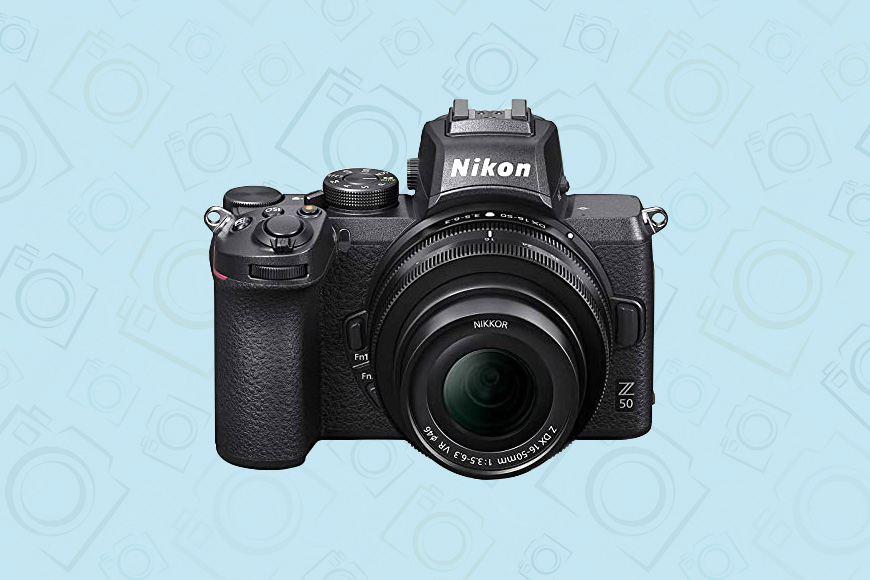
- Magnesium weather-sealed body
- Full HD up to 120 FPS
- 180° flip-under tilting screen is great for selfies and vlogging
- 20.9MP CMOS sensor
- Flip screen can get blocked by tripod quick-release plates
- Battery life is limited
Specs: 20.9MP DX-Format CMOS Sensor | EXPEED 6 Image Processor | UHD 4K and Full HD Video Recording | 3.2″ 1.04m-Dot Tilting Touchscreen LCD | 11 fps Continuous Shooting; ISO 100-51200 | DX NIKKOR 16-50mm f/3.5-6.3 VR Lens | Built-In Wi-Fi and Bluetooth Connectivity | 209-Point Hybrid AF System | Eye-Detection AF and Animal-Detection AF | In-Camera Time-Lapse, Up to 120 fps.
The Nikon Z50 Mirrorless Camera isn’t quite as affordable as other budget cameras on this list, but if you can stretch your budget just a little bit this is an excellent mirrorless camera with some pretty advanced features.
One of the most impactful things that I love about the Nikon Z50 Mirrorless Camera as a budget camera is that it comes with the NIKKOR Z DX 16-50mm f/3.5-6.3 VR lens. This lens has vibration reduction which can help you manage camera shake.
That focal length converts to a 24-75mm-equivalent on 35 mm, full frame cameras. That’s a focal length coverage that can handle everything from landscapes to portraits.
The Nikon Z50 Mirrorless Camera is also a solid budget choice if you’re looking to go beyond what your smartphone can accomplish when it comes to video.
This budget mirrorless camera is capable of filming in 4k, but it limits you to 30 frames per second at that resolution. However, it can do 120 FPS at full HD which even lets you get some cool slow-motion shots.
If you’re hoping to find a budget camera that you can take to events or do some nighttime street photography, the Nikon Z50 Mirrorless Camera has surprisingly good low-light performance. The ISO of this camera tops out at 51,200 and it comes with a built-in flash to help with dim lighting.
This camera also works with the Nikon SnapBridge app and can connect over Bluetooth or wi-fi. You can quickly transfer pics to your smartphone or use the SnapBridge app as a remote control for this camera. That’s an invaluable feature if you’re looking to take your selfie game to a whole new level.
If you’ve got a few extra dollars in your budget, the Nikon Z50 Mirrorless Camera is going to give you something much closer to high-budget, full frame mirrorless cameras.
That’s why it made our list of the best budget-friendly cameras – it’s not the cheapest, but the value for money is outstanding.
Google Pixel | Best Budget Camera Phone (Android)
![]()
- 50 megapixel wide-angle rear camera
- Ultra-wide second rear lens
- Built-in photo editing software is pretty powerful
- 4k video at 60 fps on the main camera
- Budget smartphone that can compete with “pro” models
- Missing the 48 megapixel telephoto camera
Specs: Display: 5.0 inches AMOLED, FHD+ (1080 x 1920 pixels) | Processor: Qualcomm Snapdragon 765G, Octa-core | Memory and Storage: 6GB RAM, 128GB Storage | Rear Camera: 12.2MP Dual-Pixel, f/1.7 aperture, OIS, EIS | Front Camera: 8MP, f/2.0 aperture | Battery: 3,140mAh, 18W fast charging, USB-C | OS: Android 11 | Other features: 5G capable, Titan M security module, IP68 water and dust resistance, Rear-mounted fingerprint sensor.
You really can’t talk about affordable cameras without talking about smartphones. if you get the right model smartphone, it’s going to be just as good—if not better—than half of the budget point-and-click cameras out there.
The Google Pixel 6 is a great example of a budget smartphone that has a camera that can compete with most crop sensor cameras and pocket cameras.
The Google Pixel 6 comes with three separate lens options built into its camera. You get a 50 megapixel wide angle lens, a 12 megapixel ultra-wide lens, and an 8-megapixel front-facing selfie camera.
Yes, more expensive models come with the sought-after 48-megapixel telephoto lens, but the three options on the base model give you plenty of utility and focal length coverage.
Google also added some powerful photo editing features to this smartphone. You can unblur faces, erase unwanted photo bombers from your selfie, and make a variety of other basic edits without having to pay for a photo editing app.
Video capability is always at a premium with affordable cameras. The Google Pixel 6 gives you 4K video at 60fps, but you’ll get better results by dropping down to 4K30 at 48 Mbps bit rate in the h.264 codec.
Smartphone photographers are going to love the battery on the Google Pixel 6. It’s rated to last 48 hours under average use and you can definitely shoot pics all day without worrying about putting too much strain on the battery.
There’s a lot to consider when looking at a budget smartphone, but one of the things I think it’s important to look at is the overall experience. Some people have raised an issue with the thumbprint security technology on this phone not being too reliable.
I’d recommend sticking with other ways of locking your phone. There’s nothing worse than watching the shot of a lifetime pass you by because you couldn’t get your smartphone unlocked fast enough.
Fans of Android smartphones who are looking for an upgrade we’ll find great photo and video utility in the Google Pixel 6.
iPhone XR | Best Budget Camera Phone (iOS)
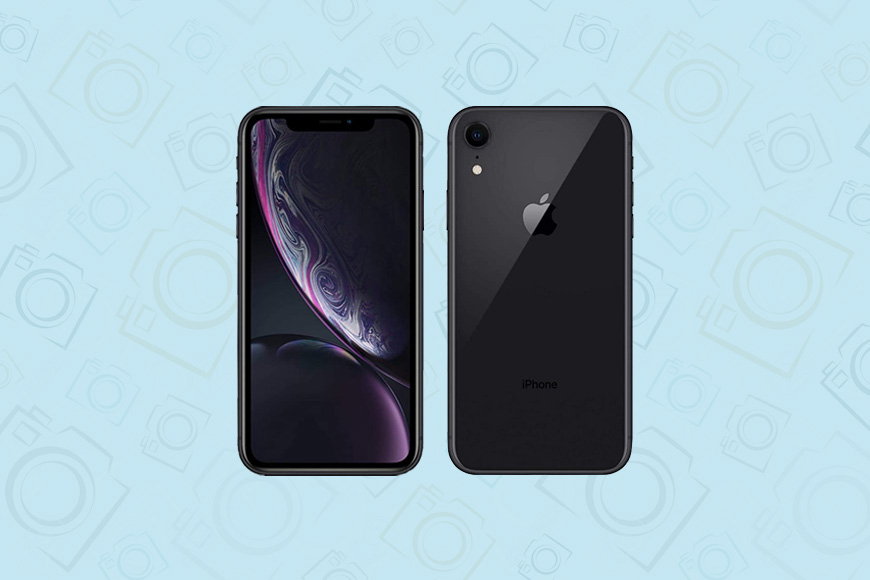
- 4K video up to 60 fps
- Optical image stabilisation
- Rear camera has a bright f/1.8 aperture
- Ability to take pics while filming in 4K
- Only one rear-facing camera
- Megapixels lower than the competition
Specs: Display: 6.1 inches Liquid Retina HD display (828 x 1792 pixels) | Processor: A12 Bionic chip with next-generation Neural Engine | Memory and Storage: 3GB RAM, 64GB or 128GB or 256GB Storage | Rear Camera: 12MP Wide camera, f/1.8 aperture, OIS | Front Camera: 7MP TrueDepth camera, f/2.2 aperture | Battery: Built-in rechargeable lithium-ion battery, Up to 25 hours talk time | OS: iOS 14 | Other features: Face ID, Water and dust resistance (IP67), Wireless charging capability.
The iPhone XR is a great choice for fans of iOS who want a budget-friendly option that doesn’t compromise too much on the camera.
I’ll address the elephant in the room first. The iPhone XR does not come with multiple rear-facing lenses like its Android counterpart.
This means you’ll be relying on digital zoom a little bit more and your focal length options will be slightly limited. However, at this price point I don’t consider that to be a deal breaker.
The one rear facing camera you do get has an impressive f/1.8 aperture, 12 megapixels, and six elements built into the lens. The megapixels might be a little low, but 12 megapixels enough if your main goal is to post photos and video on social media.
The strength of the cameras on the iPhone rest partly on Apple’s commitment to the software that runs these digital cameras. This is great news for people shopping for a budget iPhone as it means that the software powering your camera is still going to be pretty impressive.
The camera on the smartphone gives you some nuanced control over your bokeh, has several different options for portrait mode and lighting choices, and even lets you stitch together panoramas or create HDR photographs.
The camera on the iPhone XR isn’t just good for still photography. This is also a powerful 4K video machine.
You can film video in 4k at 24 fps, 30 fps, and even 60 FPS on the iPhone XR. iPhone also blows the competition out of the water when it comes to slow-mo where you can film in 1080P at a staggering 240 frames per second.
In comparison with Android, the iPhone XR trades an extra rear-facing camera for more performance under the hood.
DJI Mavic Mini | Best Cheap Camera Drone
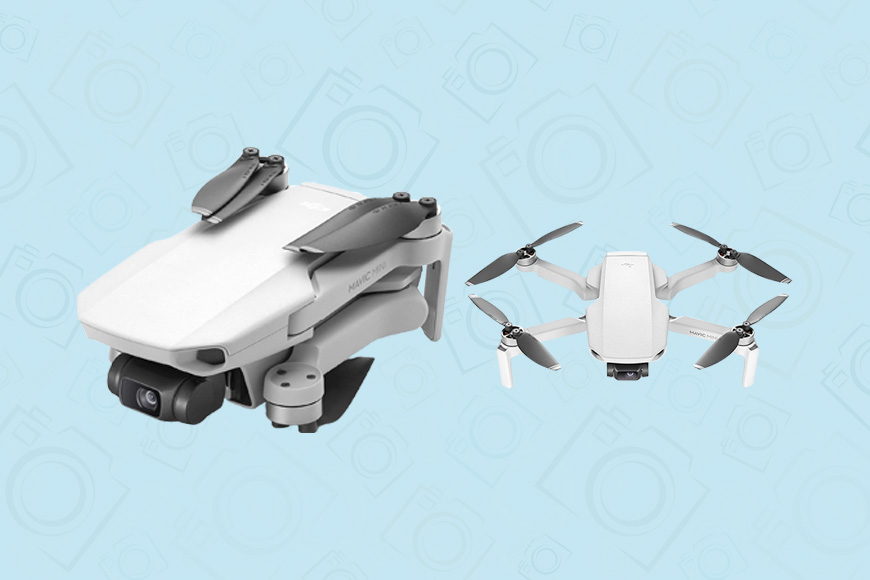
- Feather-light 250-gram weight
- Great budget drone for first-time flyers
- 30 minutes of flight time is great at this price
- 35 mm Equivalent 24 mm f/2.8 lens
- No 4K video
- No waterproofing
Specs: Aircraft Weight: 249 g | Max Flight Time: 30 minutes | Max Transmission Distance: 2.5 miles (4 km) | Max Speed: 29 mph (46.8 kph) in Sport mode without wind | Gimbal: 3-axis | Camera Sensor: 1/2.3″ CMOS | Camera Resolution: 12 MP | Video Resolution: 2.7K at 30 fps | Video Transmission: 720p at 30 fps up to 2.5 miles (4 km) | Remote Controller: Included, operates on 2.4 GHz frequency | App: DJI Fly App (compatible with iOS and Android) | Internal Storage: None (microSD card up to 256 GB supported) | Battery Capacity: 2400 mAh, 7.2 V | Charging Time: 90 minutes | Obstacle Sensing: None.
The DJI Mavic Mini is definitely an older model drone, but that’s actually what makes it the best choice for beginners and people on a budget.
You’ll be able to pick up your DJI Mavic Mini for next to nothing when it comes to the cost of drones. That’s perfect for a starter drone that can teach you how to fly so you don’t have to worry about crashing a more considerable investment down the road.
Just because this is an older drone, doesn’t mean it’s outdated.
Yes, the DJI Mavic Mini does not have 4K capability, but 2.7K is still very impressive. The video quality on this drone is ideal for uploading your videos to social media and getting started with content creation as you work your way up to a 4K drone.
This drone can handle 2.7 K video up to 30 frames per second and Full HD video up to 60 frames per second. Drone photographers will get access to a 12 megapixel camera with a max image size of 4000×3000 pixels.
This drone also has 30 minutes of flight time. That’s definitely less than more expensive drones, but it’s great for an older model that’s this budget friendly.
The gimbal on this drone has useful controls that have aged well. The DJI Mavic Mini has tilt, pan, and roll stabilisation and offers you -90° to 0° tilt control.
The DJI Mavic Mini is officially listed as having a 249 gram takeoff weight. This is just underneath the licensing requirement for a camera drone which means that you can see if piloting a photo or video drone is right for you without worrying about as many regulations.
The DJI Mavic Mini is a great choice for photographers and videographers who want a budget drone that still has impressive features.
Key Things to Consider When Choosing a Budget Camera
You’ll see that there’s not a great deal of price difference between the most and the least expensive camera brands in this guide.
Sure, there are cameras out there for under $500, but I wouldn’t recommend them to anyone who has a modern smartphone.
Why? Well, because even a mid-range iPhone or Android device can usually take just as good a photo as a really cheap camera. There’s no point in having two devices in your pocket which essentially produce the same image.
So my advice for choosing the best camera if you’re on a budget is first to work out the maximum you want to spend (obviously), then decide using these four factors:
- Size – check the dimensions of the cameras below. You may prefer to have something you can fit in a jeans pocket or small handbag. If it’s not a priority, a larger camera body usually means better ergonomics and battery life.
- Battery Life – this may or may not be important to you. If you travel and won’t have access to a charger or won’t be able to carry spares, a larger camera usually has better battery life. For most people, though, we charge our devices every day, so this isn’t an issue.
- Brand – Sony, Nikon, Canon, Fujifilm… they’re all pretty similar. What I mean here is whether you expect to be buying lenses for your camera later down the track. Take a peek at the prices of lenses from each brand, or see if the focal length you need is available.
- Autofocus Speed – will you be shooting sports or fast-moving action? (Kids, pets, etc.?) If so, fast AF should be a priority. Some cameras below fare better than others in this department.
Bonus Tip: Don’t worry so much about when the camera was released. You can get a great bargain on a camera that’s a few years old, that still takes great photos and has excellent features. Some of the ones I recommend above are around five years old but can still outperform even the latest smartphones.
Which is Cheaper: DSLR or Mirrorless?
One of the biggest changes to the entire landscape of photography has been the arrival of professional mirrorless cameras.
In one respect, mirrorless cameras should be cheaper than DSLRs because they require fewer components to build and they’re of a smaller size.
However, mirrorless cameras are also new and a lot of research has gone into building professional grade mirrorless cameras.
This means that photography is in a place where a mirrorless camera is much more expensive than a DSLR. The price gap gets even more noticeable when you consider the fact that professional camera companies like Nikon, Sony, and Canon are moving away from DSLRs and towards mirrorless cameras.
So, for now, DSLR is cheaper but this is likely to change as mirrorless continues to become the new status quo for pros and budget photographers alike.
Is Nikon or Canon cheaper?
This question is about as straightforward as it gets. Nikon is generally more affordable when you directly compare Nikon cameras to their Canon equivalent.
Depending on who you ask, Nikon is able to create more affordable cameras that have the same, or even better, quality than their Canon alternatives—but that debate is a conversation for another day!
What’s the best cheap film camera?
Final Words of Advice When Buying Cheap Cameras
There is a budget camera out there that’s right for you, whether you want to upgrade your smartphone to something with a great built-in camera or you want to jump into photography with the Fujifilm X-T1.
Always remember that a skilled photographer working with even a toy camera can create breathtaking photographs. Any of the cameras on this list can help you build up your skills as a photographer so that you can make the most of a big-budget camera.
I hope you find the best camera at the lowest price and get out there and start taking great photos today!
Don Machuca is a writer and professional photographer/videographer from Manila, Philippines who specializes in landscapes, events and product photography.







